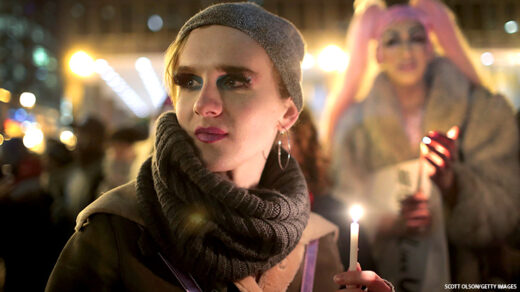Molly Knox Ostertag Talks Queer YA Visibility in The Girl From the Sea
Author: Mey Rude

Molly Knox Ostertag has been working on the story for The Girl From the Sea, her new YA graphic novel from Scholastic, for a long time.
“It’s set on this island where I spent my summers. My parents were both teachers, so they had the summers off and we would go up to Nova Scotia and be in this tiny little hut, like a fishing shack kind of on an island,” Ostertag tells The Advocate. “It was really rustic and rural and so beautiful. But as I got older, it got really lonely. So I had a lot of fantasies of meeting people and just getting swept off on a whirlwind romance or even friendship, just that kind of fantasy of having someone appear and just be there for you.”
That’s exactly what happens to 15-year-old Morgan, the protagonist of The Girl From the Sea. Morgan is gay, but she isn’t out yet. She’s not afraid that she’ll be kicked out of her home, just that she won’t be seen the same way. So she plans on waiting to come out until she moves away from her small town. Those plans fall apart when she meets Keltie, a mysterious girl with large eyes and an affinity for water. Keltie turns out to be a selkie, a mythical shape-shifting seal girl.
Ostertag wanted to do something different from other YA romances and other queer romances. Instead of going for a “will they, won’t they” vibe, she wanted to revel in the relationship. “I just really let myself be very, very indulgent with this book. I felt that the things that I enjoy drawing, the romances and these sweet, fluffy moments, I felt I enjoyed drawing them that much. Hopefully, other people would enjoy reading them,” she says.
“I really wanted to do a story where they kissed in the first 16 pages and the rest of the book is dealing with the repercussions of that kiss and trying to figure out how to have a relationship and have these separate goals that both girls have,” she adds.
She says she was excited to get to “show not only can you have crushes on girls, but you can date a girl and it could be really nice. Even if there’s other complications, there’s this fantasy wish-fulfillment of the actual romance that I hadn’t seen a lot in media for teens. So I had a lot of fun. It’s my favorite thing. If I could only draw fluffy romance all day, that would be ideal.”
She also wanted to explore a type of coming-out drama that wasn’t centered around homophobia or violence. “I’m incredibly lucky. My family was really supportive,” she says. “I remember feeling interested in girls and feeling queer in high school and feeling like I couldn’t admit it. Not because I’d be met with hate or hate crimes, but because I would be kept separate. It would separate me from my other female friends.”
That’s what she explores in The Girl From the Sea. “There’s still this fear of being known and this fear that maybe the version of me that everyone else wants me to be is better than the person I actually am. The book is very much about realizing that the person you are is the person that the people around you need and love and want to see.”
She also knows that many queer girls struggle with feeling like their attraction will make them seem like “predators” to their peers. “I wanted to explore how that very fear can make you close off to them because you’re not sharing yourself with them. That part was definitely the most digging into my feelings when I was 14, 15, 16,” she says.
While Morgan represents a part of queerness that’s afraid to be one’s true self, Keltie represents when you can’t hide that part of yourself. “I think Morgan is sometimes embarrassed of her. Then, actually, what Morgan is embarrassed of is herself and just being like, what if you take these things that are supposed to be quiet and you live it out loud and you’re messy and chaotic and just a magical creature from the ocean? I think that she breaks down Morgan’s walls because she’s so impossible to constrain.”
She continues, “You can’t put all of your desires and all of your identities into boxes. It’s going to spill out, it’s going to bleed over into your entire life, and that’s not a bad thing. Hopefully, getting that sense of empowerment and also showing that gay teenagers can have relationships and can be sweet and kind to each other and can be working through things and have drama together.”
Ostertag wanted to send a message to young people about coming out through the book, especially young people who might be afraid to come out because of how others will react.
“I think coming out is a gift that you give yourself,” she says. But also, “the act of explaining your identity to someone is a gift. That is something that they earn through being trustworthy and through loving you, and if you don’t feel you can trust the people in your life with that gift, then you don’t have to. It does not make you less valid as a queer person.”
But she also wants them to know that there are more people who will love them for being themselves than will hate them.
“Our community is so ready for you and so excited for you, and it’s not going anywhere,” she says. “So do what you need to do to be in a place where you feel safe living openly, but also know that if you feel you can come out and you’re not going to face financial consequences or be put on the street, I think the world needs you to be your greatest self.”
The Girl From the Sea is in bookstores and available online Tuesday. Check out a preview below.
Original Article on The Advocate
Author: Mey Rude





